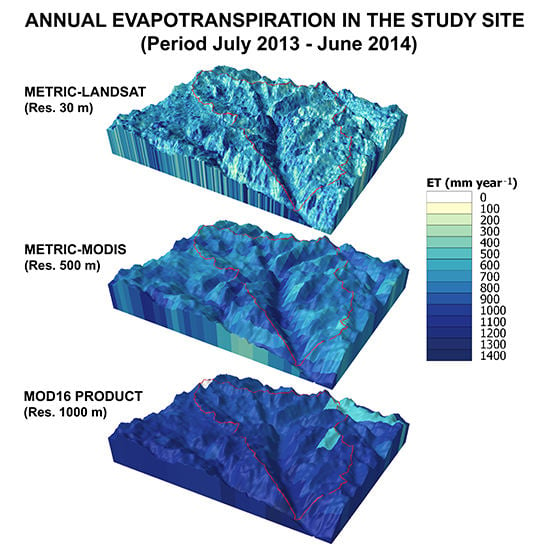Dynamic Mapping of Evapotranspiration Using an Energy Balance-Based Model over an Andean Páramo Catchment of Southern Ecuador
Abstract
:1. Introduction
2. Materials and Methods
2.1. Study Area
2.2. Weather and Stream Flow-Gage Stations
2.3. Landsat and MODIS Imagery
2.4. Pre-Processing of the Images
2.5. METRIC Model Implementation
2.5.1. METRIC Landsat-Based Implementation
- (i)
- (ii)
- The albedo was calculated according to [84].
- (iii)
- The emissivities were computed using the approach of Tasumi [92].
- (iv)
- (v)
- (vi)
- (vii)
- (viii)
- We implemented the method recommended by [53] for an adjustment of roughness length, zom, a correction of wind speed for mountainous effects and a specific calibration of the temperature lapse rate for each image.
- (ix)
- (x)
- (xi)
2.5.2. METRIC MODIS-Based Implementation
2.6. Analysis of the METRICL and METRICM Retrievals
2.7. Comparison of METRIC Retrievals with MOD16 Product
2.8. Validation of METRIC Retrievals with ET from the Water Balance
3. Results and Discussion
3.1. Reference Evapotranspiration Fraction (ETrf) and Crop Coefficient (Kc)
3.2. 24-h ET Maps
3.3. Monthly ET Retrievals and Comparison with MOD16 ET
3.4. Validation with ET from the Water Balance
4. Concluding Remarks
Supplementary Materials
Acknowledgments
Author Contributions
Conflicts of Interest
References
- Pepin, N.; Bradley, R.S.; Diaz, H.F.; Baraer, M.; Caceres, E.B.; Forsythe, N.; Fowler, H.; Greenwood, G.; Hashmi, M.Z.; Liu, X.D.; et al. Elevation-dependent warming in mountain regions of the world. Nat. Clim. Chang. 2015, 5, 424–430. [Google Scholar] [CrossRef] [Green Version]
- Krishnaswamy, J.; John, R.; Joseph, S. Consistent response of vegetation dynamics to recent climate change in tropical mountain regions. Glob. Chang. Biol. 2014, 20, 203–215. [Google Scholar] [CrossRef] [PubMed]
- Mora, D.E.; Campozano, L.; Cisneros, F.; Wyseure, G.; Willems, P. Climate changes of hydrometeorological and hydrological extremes in the Paute basin, Ecuadorean Andes. Hydrol. Earth Syst. Sci. 2014, 18, 631–648. [Google Scholar] [CrossRef] [Green Version]
- Vuille, M.; Bradley, R.S.; Werner, M.; Keimig, F. 20th century climate change in the tropical Andes: Observations and model results. In Climate Variability and Change in High Elevation Regions: Past, Present & Future; Springer: Houten, The Netherlands, 2003; pp. 75–99. [Google Scholar]
- Vuille, M.; Franquist, E.; Garreaud, R.; Lavado Casimiro, W.S.; Cáceres, B. Impact of the global warming hiatus on Andean temperature. J. Geophys. Res. Atmos. 2015, 120, 3745–3757. [Google Scholar] [CrossRef]
- Mosquera, G.M.; Lazo, P.X.; Célleri, R.; Wilcox, B.P.; Crespo, P. Runoff from tropical alpine grasslands increases with areal extent of wetlands. Catena 2015, 125, 120–128. [Google Scholar] [CrossRef]
- Crespo, P.; Celleri, R.; Buytaert, W.; Feyen, J. Land use change impacts on the hydrology of wet Andean páramo ecocystems. In Proceedings of the Workshop Status and Perspectives of Hydrology in Small Basins, Goslar-Hahnenklee, Germany, 30 March–2 April 2009; IAHS Publications: Wallingford, UK, 2010; p. 336. [Google Scholar]
- Thies, B.; Meyer, H.; Nauss, T.; Bendix, J. Projecting land-use and land-cover changes in a tropical mountain forest of Southern Ecuador. J. Land Use Sci. 2014, 9, 1–33. [Google Scholar] [CrossRef]
- Balthazar, V.; Vanacker, V.; Molina, A.; Lambin, E.F. Impacts of forest cover change on ecosystem services in high Andean mountains. Ecol. Indic. 2015, 48, 63–75. [Google Scholar] [CrossRef]
- Llambí, L.D.; Soto-W, A.; Célleri, R.; de Bievre, B.; Ochoa, B.; Borja, P. Ecología, Hidrología y Suelos de Páramos. Proyecto Páramo Andino; Universidad de Los Andes: Bogotá, Colombia, 2012. [Google Scholar]
- Córdova, M.; Carrillo-Rojas, G.; Crespo, P.; Wilcox, B.; Célleri, R. Evaluation of the Penman-Monteith (FAO 56 PM) method for calculating reference evapotranspiration using limited data. Mt. Res. Dev. 2015, 35, 230–239. [Google Scholar] [CrossRef]
- Córdova, M.; Carrillo, G.; Célleri, R. Errores en la Estimación de la Evapotranspiración de Referencia de una zona de Páramo Andino debidos al uso de datos Mensuales, Diarios y Horarios. Aqua-LAC 2013, 5, 14–22. [Google Scholar]
- Karimi, P.; Bastiaanssen, W.G.M. Spatial evapotranspiration, rainfall and land use data in water accounting—Part 1: Review of the accuracy of the remote sensing data. Hydrol. Earth Syst. Sci. Discuss. 2014, 11, 1073–1123. [Google Scholar] [CrossRef]
- Gowda, P.H.; Chavez, J.L.; Colaizzi, P.D.; Evett, S.R.; Howell, T.A.; Tolk, J.A. ET mapping for agricultural water management: Present status and challenges. Irrig. Sci. 2008, 26, 223–237. [Google Scholar] [CrossRef]
- Liou, Y.A.; Kar, S.K. Evapotranspiration estimation with remote sensing and various surface energy balance algorithms—A review. Energies 2014, 7, 2821–2849. [Google Scholar] [CrossRef]
- Allen, R.G.; Pereira, L.S.; Howell, T.A.; Jensen, M.E. Evapotranspiration information reporting: I. Factors governing measurement accuracy. Agric. Water Manag. 2011, 98, 899–920. [Google Scholar] [CrossRef]
- Irmak, A. Evapotranspiration—Remote Sensing and Modeling; InTech: Rijeka, Croatia, 2011. [Google Scholar]
- Kustas, W.P.; Norman, J.M. Use of remote sensing for evapotranspiration monitoring over land surfaces. Hydrol. Sci. J. 1996, 41, 495–516. [Google Scholar] [CrossRef]
- Moran, M.S.; Jackson, R.D. Assessing the spatial distribution of evapotranspiration using remotely sensed inputs. J. Environ. Qual. 1991, 20, 725–737. [Google Scholar] [CrossRef]
- Courault, D.; Seguin, B.; Olioso, A. Review on estimation of evapotranspiration from remote sensing data: From empirical to numerical modeling approaches. Irrig. Drain. Syst. 2005, 19, 223–249. [Google Scholar] [CrossRef]
- Verstraeten, W.W.; Veroustraete, F.; Feyen, J. Assessment of evapotranspiration and soil moisture content across different scales of observation. Sensors 2008, 8, 70–117. [Google Scholar] [CrossRef]
- Li, Z.-L.; Tang, R.; Wan, Z.; Bi, Y.; Zhou, C.; Tang, B.; Yan, G.; Zhang, X. A review of current methodologies for regional evapotranspiration estimation from remotely sensed data. Sensors 2009, 9, 3801–3853. [Google Scholar] [CrossRef] [PubMed]
- Kalma, J.D.; McVicar, T.R.; McCabe, M.F. Estimating land surface evaporation: A review of methods using remotely sensed surface temperature data. Surv. Geophys. 2008, 29, 421–469. [Google Scholar] [CrossRef]
- Allen, R.G.; Tasumi, M.; Trezza, R. Satellite-based energy balance for mapping evapotranspiration with internalized calibration (METRIC)—model. J. Irrig. Drain. Eng. 2007, 133, 380–394. [Google Scholar] [CrossRef]
- Bastiaanssen, W.G.M.; Menenti, M.; Feddes, R.A.; Holtslag, A.A.M. A remote sensing surface energy balance algorithm for land (SEBAL): 1. Formulation. J. Hydrol. 1998, 212–213, 198–212. [Google Scholar] [CrossRef]
- Norman, J.M.; Kustas, W.P.; Humes, K.S. Source approach for estimating soil and vegetation energy fluxes in observations of directional radiometric surface temperature. Agric. For. Meteorol. 1995, 77, 263–293. [Google Scholar] [CrossRef]
- Su, Z. The Surface Energy Balance System (SEBS) for estimation of turbulent heat fluxes. Hydrol. Earth Syst. Sci. Discuss. 2002, 6, 85–100. [Google Scholar] [CrossRef]
- Sun, Z.; Wang, Q.; Matsushita, B.; Fukushima, T.; Ouyang, Z.; Watanabe, M. Development of a simple remote sensing evapotranspiration model (Sim-ReSET): Algorithm and model test. J. Hydrol. 2009, 376, 476–485. [Google Scholar] [CrossRef] [Green Version]
- Kustas, W.P.; Norman, J.M. Evaluation of soil and vegetation heat flux predictions using a simple two-source model with radiometric temperatures for partial canopy cover. Agric. For. Meteorol. 1999, 94, 13–29. [Google Scholar] [CrossRef]
- Anderson, M.C.; Norman, J.M.; Diak, G.R.; Kustas, W.P.; Mecikalski, J.R. A two-source time-integrated model for estimating surface fluxes using thermal infrared remote sensing. Remote Sens. Environ. 1997, 60, 195–216. [Google Scholar] [CrossRef]
- Morton, C.G.; Huntington, J.L.; Pohll, G.M.; Allen, R.G.; Mcgwire, K.C.; Bassett, S.D. Assessing calibration uncertainty and automation for estimating evapotranspiration from agricultural areas using METRIC. J. Am. Water Resour. Assoc. 2013, 49, 549–562. [Google Scholar] [CrossRef]
- Carrasco-Benavides, M.; Ortega-Farías, S.; Lagos, L.; Kleissl, J.; Morales-Salinas, L.; Kilic, A. Parameterization of the Satellite-Based Model (METRIC) for the estimation of instantaneous surface energy balance components over a drip-irrigated vineyard. Remote Sens. 2014, 6, 11342–11371. [Google Scholar] [CrossRef]
- Allen, R.; Irmak, A.; Trezza, R.; Hendrickx, J.M.H.; Bastiaanssen, W.; Kjaersgaard, J. Satellite-based ET estimation in agriculture using SEBAL and METRIC. Hydrol. Process. 2011, 25, 4011–4027. [Google Scholar] [CrossRef]
- Hankerson, B.; Kjaersgaard, J.; Hay, C. Estimation of evapotranspiration from fields with and without cover crops using remote sensing and in situ methods. Remote Sens. 2012, 4, 3796–3812. [Google Scholar] [CrossRef]
- Pôças, I.; Paço, T.; Cunha, M.; Andrade, J.; Silvestre, J.; Sousa, A.; Santos, F.L.; Pereira, L.S.; Allen, R.G. Satellite-based evapotranspiration of a super-intensive olive orchard: Application of METRIC algorithms. Biosyst. Eng. 2014, 128, 69–81. [Google Scholar] [CrossRef]
- Trezza, R.; Allen, R.G.; Tasumi, M. Estimation of actual evapotranspiration along the Middle Rio Grande of New Mexico using MODIS and landsat imagery with the METRIC model. Remote Sens. 2013, 5, 5397–5423. [Google Scholar] [CrossRef]
- Allen, R.G.; Tasumi, M.; Morse, A.; Trezza, R.; Wright, J.L.; Bastiaanssen, W.; Kramber, W.; Lorite, I.; Robison, C.W. Satellite-based energy balance for mapping evapotranspiration with internalized calibration (METRIC)—Applications. J. Irrig. Drain. Eng. 2007, 133, 395–406. [Google Scholar] [CrossRef]
- Kjaersgaard, J.; Allen, R.; Irmak, A. Improved methods for estimating monthly and growing season ET using METRIC applied to moderate resolution satellite imagery. Hydrol. Process. 2011, 25, 4028–4036. [Google Scholar] [CrossRef]
- Kamble, B.; Irmak, A.; Martin, D.L.; Hubbard, K.G.; Ratcliffe, I.; Hergert, G.; Narumalani, S.; Oglesby, R.J. Satellite based energy balance approach to assess riparian water use. In Evapotranspiration—An Overview; InTech: Rijeka, Croatia, 2013. [Google Scholar]
- Singh, R.K.; Liu, S.; Tieszen, L.L.; Suyker, A.E.; Verma, S.B. Estimating seasonal evapotranspiration from temporal satellite images. Irrig. Sci. 2012, 30, 303–313. [Google Scholar] [CrossRef]
- Pôças, I.; Cunha, M.; Pereira, L.S.; Allen, R.G. Using remote sensing energy balance and evapotranspiration to characterize montane landscape vegetation with focus on grass and pasture lands. Int. J. Appl. Earth Obs. Geoinf. 2013, 21, 159–172. [Google Scholar] [CrossRef]
- Allen, R.G.; Trezza, R.; Kilic, A.; Tasumi, M.; Li, H. Sensitivity of landsat-scale energy balance to aerodynamic variability in mountains and complex terrain. J. Am. Water Resour. Assoc. 2013, 49, 592–604. [Google Scholar] [CrossRef]
- Allen, R.G.; Kjaersgaard, J.H.; Trezza, R.; Oliveira, A.; Robison, C.; Lorite-Torres, I. Refining components of a satellite-based surface energy balance model to complex land-use systems. IAHS-AISH Publ. 2012, 2012, 73–75. [Google Scholar]
- Senay, G.B.; Budde, M.E.; Verdin, J.P. Enhancing the Simplified Surface Energy Balance (SSEB) approach for estimating landscape ET: Validation with the METRIC model. Agric. Water Manag. 2011, 98, 606–618. [Google Scholar] [CrossRef]
- Dastorani, M.T.; Poormohammadi, S. Evaluation of water balance in a mountainous upland catchment using SEBAL approach. Water Resour. Manag. 2012, 26, 2069–2080. [Google Scholar] [CrossRef]
- Li, Z.; Liu, X.; Ma, T.; Kejia, D.; Zhou, Q.; Yao, B.; Niu, T. Retrieval of the surface evapotranspiration patterns in the alpine grassland-wetland ecosystem applying SEBAL model in the source region of the Yellow River, China. Ecol. Modell. 2013, 270, 64–75. [Google Scholar] [CrossRef]
- Kiptala, J.K.; Mohamed, Y.; Mul, M.L.; Van Der Zaag, P. Mapping evapotranspiration trends using MODIS and SEBAL model in a data scarce and heterogeneous landscape in Eastern Africa. Water Resour. Res. 2013, 49, 8495–8510. [Google Scholar] [CrossRef]
- Mkhwanazi, M. Developing a Modified SEBAL Algorithm that Is Responsive to Advection by Using Limited Weather Data. Ph.D. Thesis, Colorado State University, Fort Collins, CO, USA, 2014. [Google Scholar]
- Jassas, H.; Kanoua, W.; Merkel, B. Actual evapotranspiration in the Al-Khazir Gomal Basin (Northern Iraq) using the surface energy balance algorithm for land (SEBAL) and water balance. Geosciences 2015, 5, 141–159. [Google Scholar] [CrossRef]
- Liu, C.; Gao, W.; Gao, Z.; Xu, S. Improvements of regional evapotranspiration model by considering topography correction. Proc. SPIE 2008, 7083, 70830L. [Google Scholar]
- Kjaersgaard, J.H.; Allen, R.G.; Trezza, R.; Olivieria, A. Refining components of satellite based surface energy balance models for forests and steep terrain. In Proceedings of the 3rd USGS Modeling Conference, Denver, CO, USA, 7–11 June 2010.
- Hansen, F.V. Surface Roughness Lengths; U.S. Army Research Laboratory: Adelphi, MD, USA, 1993. [Google Scholar]
- Allen, R.G.; Kjaersgaard, J.H.; Garcia, M. Fine-tuning components of inverse-calibrated, thermal-based remote sensing models for evapotranspiration. In Proceedings of the Pecora 17—The Future of Land Imaging Going Operational, Denver, CO, USA, 18–20 November 2008.
- Allen, R.G.; Trezza, R.; Tasumi, M. Analytical integrated functions for daily solar radiation on slopes. Agric. For. Meteorol. 2006, 139, 55–73. [Google Scholar] [CrossRef]
- Mu, Q.; Heinsch, F.A.; Zhao, M.; Running, S.W. Development of a global evapotranspiration algorithm based on MODIS and global meteorology data. Remote Sens. Environ. 2007, 111, 519–536. [Google Scholar] [CrossRef]
- Glenn, E.P.; Neale, C.M.U.; Hunsaker, D.J.; Nagler, P.L. Vegetation index-based crop coefficients to estimate evapotranspiration by remote sensing in agricultural and natural ecosystems. Hydrol. Process. 2011, 25, 4050–4062. [Google Scholar] [CrossRef]
- Murray, R.S.; Nagler, P.L.; Morino, K.; Glenn, E.P.; Murray, R.S.; Osterberg, J.; Glenn, E.P. An empirical algorithm for estimating agricultural and riparian evapotranspiration using MODIS enhanced vegetation index and ground measurements of ET. I. Description of method. Remote Sens. 2009, 1, 1125–1138. [Google Scholar] [CrossRef]
- Zhang, J.; Hu, Y.; Xiao, X.; Chen, P.; Han, S.; Song, G.; Yu, G. Satellite-based estimation of evapotranspiration of an old-growth temperate mixed forest. Agric. For. Meteorol. 2009, 149, 976–984. [Google Scholar] [CrossRef]
- Guerschman, J.P.; Van Dijk, A.I.J.M.; Mattersdorf, G.; Beringer, J.; Hutley, L.B.; Leuning, R.; Pipunic, R.C.; Sherman, B.S. Scaling of potential evapotranspiration with MODIS data reproduces flux observations and catchment water balance observations across Australia. J. Hydrol. 2009, 369, 107–119. [Google Scholar] [CrossRef]
- Mu, Q.; Zhao, M.; Running, S.W. Improvements to a MODIS global terrestrial evapotranspiration algorithm. Remote Sens. Environ. 2011, 115, 1781–1800. [Google Scholar] [CrossRef]
- Glenn, E.P.; Nagler, P.L.; Huete, A.R. Vegetation index methods for estimating evapotranspiration by remote sensing. Surv. Geophys. 2010, 31, 531–555. [Google Scholar] [CrossRef]
- Velpuri, N.M.; Senay, G.B.; Singh, R.K.; Bohms, S.; Verdin, J.P. A comprehensive evaluation of two MODIS evapotranspiration products over the conterminous United States: Using point and gridded FLUXNET and water balance ET. Remote Sens. Environ. 2013, 139, 35–49. [Google Scholar] [CrossRef]
- Vinukollu, R.K.; Wood, E.F.; Ferguson, C.R.; Fisher, J.B. Global estimates of evapotranspiration for climate studies using multi-sensor remote sensing data: Evaluation of three process-based approaches. Remote Sens. Environ. 2011, 115, 801–823. [Google Scholar] [CrossRef]
- Josse, C.; Cuesta, F.; Navarro, G.; Barrena, V.; Cabrera, E.; Chacón-Moreno, E.; Ferreira, W.; Peralvo, M.; Saito, J.; Tovar, A. Ecosistemas de los Andes del Norte y Centro. Bolivia, Colombia, Ecuador, Perú y Venezuela; Secretaría General de la Comunidad Andina, Programa Regional ECOBONA-Intercooperation, CONDESAN-Proyecto Páramo Andino, Programa BioAndes, EcoCiencia, NatureServe, IAvH, LTA-UNALM, ICAE-ULA, CDC-UNALM, RUMBOL SRL: Lima, Peru, 2009. [Google Scholar]
- Hastenrath, S. The glaciation of the Ecuadorian Andes. EOS Trans. Am. Geophys. Union 1981, 63, 835–836. [Google Scholar]
- Emck, P. A Climatology of South Ecuador: With special focus on the major Andean Ridge as Atlantic-Pacific climate divide. Ph.D. Thesis, Friedrich-Alexander-Universität Erlangen-Nürnberg, Erlangen, Germany, 2007. [Google Scholar]
- Bendix, J.; Rollenbeck, R.; Göttlicher, D.; Cermak, J. Cloud occurrence and cloud properties in Ecuador. Clim. Res. 2006, 30, 133–147. [Google Scholar] [CrossRef]
- Vuille, M.; Bradley, R.S.; Keimig, F. Climate variability in the andes of ecuador and its relation to tropical Pacific and Atlantic sea surface temperature anomalies. J. Clim. 2000, 13, 2520–2535. [Google Scholar] [CrossRef]
- Bendix, J.; Rollenbeck, R.; Ritcher, M.; Fabian, P.; Emck, P. Climate. In Gradients in a Tropical Mountain Ecosystem of Ecuador. Ecological Studies; Beck, E., Bendix, J., Kottke, I., Makeschin, F., Mosandl, R., Eds.; Springer Verlag: Berlin, Germany, 2008; Volume 198, pp. 63–74. [Google Scholar]
- The United Nations Educational, Scientific and Cultural Organization (UNESCO). Cajas Massif Biosphere Reserve. Available online: http://www.unesco.org/new/en/natural-sciences/environment/ecological-sciences/biosphere-reserves/latin-america-and-the-caribbean/ecuador/macizo-del-cajas/ (accessed on 1 Janaury 2015).
- Beck, E.; Makeschin, F.; Haubrich, F.; Richter, M.; Bendix, J.; Valerezo, C. The ecosystem (Reserva Biológica San Francisco): Geology. In Gradients in a Tropical Mountain Ecosystem of Ecuador. Ecological Studies; Beck, E., Bendix, J., Kottke, I., Makeschin, F., Mosandl, R., Eds.; Springer Verlag: Berlin, Germany, 2008; Volume 198, p. 4. [Google Scholar]
- Célleri, R.; Feyen, J. The hydrology of tropical andean ecosystems: importance, knowledge status, and perspectives. Mt. Res. Dev. 2009, 29, 350–355. [Google Scholar] [CrossRef] [Green Version]
- WRB-IUSS. International Soil Classification System for Naming Soils and Creating Legends for Soil Maps; FAO: Rome, Italy, 2014; Volume 106. [Google Scholar]
- Crespo, P.J.; Feyen, J.; Buytaert, W.; Bücker, A.; Breuer, L.; Frede, H.-G.G.; Ramírez, M. Identifying controls of the rainfall-runoff response of small catchments in the tropical Andes (Ecuador). J. Hydrol. 2011, 407, 164–174. [Google Scholar] [CrossRef]
- Aucapiña, G.; Marín, F. Efectos de la Posición Fisiográfica en las Propiedades Hidrofísicas de los Suelos de Páramo de la Microcuenca del Río Zhurucay. Bachelor’s Thesis, Universidad de Cuenca, Cuenca, Ecuador, 2014. [Google Scholar]
- Quichimbo, P.; Tenorio, G.; Borja, P.; Cárdenas, I.; Crespo, P.; Célleri, R. Efectos sobre las propiedades físicas y químicas de los suelos por el cambio de la cobertura vegetal y uso del suelo: Páramo de Quimsacocha al sur del Ecuador. Suelos Ecuator. 2012, 42, 138–153. [Google Scholar]
- Sklenář, P.; Jørgensen, P.M. Distribution patterns of páramo plants in Ecuador. J. Biogeogr. 1999, 26, 681–691. [Google Scholar] [CrossRef]
- Crespo, A.; Pinos, N.; Chacón, G. Determinación del Rango de Variación del Índice de Vegetación con Imágenes Satélite en el Parque Nacional Cajas. Bachelor’s Thesis, Universidad del Azuay, Cuenca, Ecuador, 2007. [Google Scholar]
- Mark, A.F. Ecology of snow tussocks in the mountain grasslands of New Zealand. Vegetatio 1969, 18, 289–306. [Google Scholar] [CrossRef]
- Luteyn, J.L.; Churchill, S.P. Páramos: A Checklist of Plant Diversity, Geographical Distribution, and Botanical Literature; New York Botanical Garden Press: Bronx, NY, USA, 1999. [Google Scholar]
- Buytaert, W.; Iñiguez, V.; Celleri, R.; De Biévre, B.; Wyseure, G.; Deckers, J.; Célleri, R. Analysis of the water balance of small páramo catchments in south Ecuador. In Environmental Role of Wetlands in Headwaters; Springer: Houten, The Netherlands, 2006; pp. 271–281. [Google Scholar]
- Zahumensky, I.; Shmi, J. Guidelines on Quality Control Procedures for Data from Automatic Weather Stations; World Meteorological Organization: Geneva, Switzerland, 2004. [Google Scholar]
- Celleri, R.; Willems, P.; Buytaert, W.; Feyen, J. Space-time rainfall variability in the Paute basin, Ecuadorian Andes. Hydrol. Process. 2007, 21, 3316–3327. [Google Scholar] [CrossRef]
- Tasumi, M.; Allen, R.G.; Trezza, R. At-surface reflectance and albedo from satellite for operational calculation of land surface energy balance. J. Hydrol. Eng. 2008, 13, 51–63. [Google Scholar] [CrossRef]
- Gap-Filling Landsat 7 SLC-off Single Scenes Using ERDAS Imagine™. Available online: http://landsat.usgs.gov/ERDAS_Approach.php (accessed on 1 January 2013).
- Zhu, Z.; Woodcock, C.E. Object-based cloud and cloud shadow detection in Landsat imagery. Remote Sens. Environ. 2012, 118, 83–94. [Google Scholar] [CrossRef]
- Kjaersgaard, J.; Richard, A.; Trezza, R.; Robinson, C.; Oliveira, A.; Dhungel, R.; Kra, E. Filling satellite image cloud gaps to create complete images of evapotranspiration. IAHS Publ. 2012, 2012, 102–105. [Google Scholar]
- Tachikawa, T.; Kaku, M.; Iwasaki, A.; Gesch, D.; Oimoen, M.; Zhang, Z.; Danielson, J.; Krieger, T.; Curtis, B.; Haase, J.; et al. ASTER Global Digital Elevation Model Version 2-Summary of Validation Results; NASA: Siuox Falls, SD, USA, 2011.
- LP DAAC ASTER GDEM v2. Available online: http://gdex.cr.usgs.gov/gdex/ (accessed on 1 November 2014).
- Ministerio del Ambiente del Ecuador Mapa de Ecosistemas del Ecuador Continental. Available online: http://geoportal.ambiente.gob.ec/portal (accessed on 4 April 2014).
- Duffie, J.A.; Beckman, W.A. Solar Engineering of Thermal Processes, 2nd ed.; Wiley Interscience: New York, NY, USA, 1991. [Google Scholar]
- Tasumi, M. Progress in Operational Estimation of Regional Evapotranspiration Using Satellite Imagery. Ph.D. Thesis, University of Idaho, Moscow, ID, USA, 2003. [Google Scholar]
- Bastiaanssen, W.G.M. Remote Sensing in Water Resources Management: The State of the Art; International Water Management Institute: Colombo, Sri Lanka, 1998. [Google Scholar]
- Huete, A.R. A soil-adjusted vegetation index (SAVI). Remote Sens. Environ. 1988, 25, 295–309. [Google Scholar] [CrossRef]
- Markham, B.L.; Barker, J.L. Landsat MSS and TM post-calibration dynamic ranges, exoatmospheric reflectances and at-satellite temperatures. EOSAT Landsat Tech. Notes 1986, 1, 3–8. [Google Scholar]
- Wukelic, G.E.; Gibbons, D.E.; Martucci, L.M.; Foote, H.P. Radiometric calibration of Landsat Thematic Mapper thermal band. Remote Sens. Environ. 1989, 28, 339–347. [Google Scholar] [CrossRef]
- SEBAL Remote Sensing Tool for Water Consumption. Available online: http://www.waterwatch.nl/publications/posters/the-sebal-remote-sensing-tool-for-water-consumption.html (accesson on 16 February 2016).
- Cuenca, R.H.; Ciotti, S.P.; Hagimoto, Y. Application of landsat to evaluate effects of irrigation forbearance. Remote Sens. 2013, 5, 3776–3802. [Google Scholar] [CrossRef]
- Brutsaert, W. Evaporation into the Atmosphere: Theory, History and Applications; Springer: Dordrecht, The Netherlands, 1982; Volume 1. [Google Scholar]
- Yang, R.; Friedl, M.A. Determination of roughness lengths for heat and momentum over boreal forests. Bound.-Layer Meteorol. 2003, 107, 581–603. [Google Scholar] [CrossRef]
- ASCE-EWRI. The ASCE Standardized Reference Evapotranspiration Equation; ASCE–EWRI Standardization of Reference Evapotranspiration Task Committe Report; ASCE: Reston, WV, USA, 2005. [Google Scholar]
- Irmak, A.; Allen, R.G.; Kjaersgaard, J.; Huntington, J.; Kamble, B.; Trezza, R.; Ratcliffe, I.; Kjaersgaard, J.; Huntington, J.; Trezza, R.; et al. Evapotranspiration—Remote Sensing and Modeling; InTech: Rijeka, Croatia, 2012. [Google Scholar]
- MODIS Leaf Area Index (LAI) and Fraction of Photosynthetically Active Radiation Absorbed by Vegetation (FPAR) Product (MOD15) Algorithm Theoretical Basis Document. Available online: http://eospso.gsfc.nasa.gov/atbd/modistables.html (accessed on 1 December 2014).
- Allen, R.G.; Burnett, B.; Kramber, W.; Huntington, J.; Kjaersgaard, J.; Kilic, A.; Kelly, C.; Trezza, R. Automated calibration of the METRIC-Landsat evapotranspiration process. J. Am. Water Resour. Assoc. 2013, 49, 563–576. [Google Scholar] [CrossRef]
- Ackerman, S.; Strabala, K.; Menzel, P.; Frey, R.; Moeller, C.; Gumley, L. Discriminating Clear-Sky from Cloud with MODIS Algorithm Theoretical Basis Document (MOD35); MODIS Cloud Mask Team, Cooperative Institute for Meteorological Satellite Studies, University of Wisconsin: Madison, WI, USA, 2010. [Google Scholar]
- Allen, R.G.; Pereira, L.; Raes, D.; Smith, M. Crop Evapotranspiration-Guidelines for Computing Crop Water Requirements—FAO Irrigation and Drainage Paper; FAO: Rome, Italy, 1998. [Google Scholar]
- Mu, Q.; Zhao, M.; Running, S. Brief Introduction to MODIS Evapotranspiration Data Set (MOD16); University of Montana: Missoula, MT, USA, 2014; pp. 1–4. [Google Scholar]
- Buytaert, W.; Célleri, R.; De Bièvre, B.; Cisneros, F.; Wyseure, G.; Deckers, J.; Hofstede, R. Human impact on the hydrology of the Andean páramos. Earth-Sci. Rev. 2006, 79, 53–72. [Google Scholar] [CrossRef] [Green Version]
- Chow, V.T.; Maidment, D.R.; Mays, L.W. Applied Hydrology; McGraw-Hill: New York, NY, USA, 1988. [Google Scholar]
- Hongve, D. A revised procedure for discharge measurement by means of the salt dilution method. Hydrol. Process. 1987, 1, 267–270. [Google Scholar] [CrossRef]
- Moore, R.D. Introduction to salt dilution gauging for streamflow measurement: Part 1. Streamline Watershed Manag. Bull. 2004, 7, 20–23. [Google Scholar]
- Cancela, J.J.; Cuesta, T.S.; Neira, X.X.; Pereira, L.S. Modelling for improved irrigation water management in a temperate region of Northern Spain. Biosyst. Eng. 2006, 94, 151–163. [Google Scholar] [CrossRef]
- Ruhoff, A.L.; Paz, A.R.; Collischonn, W.; Aragao, L.E.O.C.; Rocha, H.R.; Malhi, Y.S. A MODIS-Based energy balance to estimate evapotranspiration for clear-sky days in Brazilian Tropical Savannas. Remote Sens. 2012, 4, 703–725. [Google Scholar] [CrossRef]
- Ramsay, P.M. The Páramo Vegetation of Ecuador: The Community Ecology, Dynamics and Productivity of Tropical Grasslands in the Andes. Ph.D. Thesis, University of Wales, Cardiff, UK, 1992. [Google Scholar]
- Ruhoff, A.L.; Paz, A.R.; Aragao, L.E.O.C.; Mu, Q.; Malhi, Y.; Collischonn, W.; Rocha, H.R.; Running, S.W. Assessment of the MODIS global evapotranspiration algorithm using eddy covariance measurements and hydrological modelling in the Rio Grande basin. Hydrol. Sci. J. 2013, 58, 1658–1676. [Google Scholar] [CrossRef]
- Kim, H.W.; Hwang, K.; Mu, Q.; Lee, S.O.; Choi, M. Validation of MODIS 16 global terrestrial evapotranspiration products in various climates and land cover types in Asia. KSCE J. Civ. Eng. 2012, 16, 229–238. [Google Scholar] [CrossRef]
- Ferreira-Junior, P.; Sousa, A.M.; Vitorino, M.I.; de Souza, E.B.; de Souza, P.J.O.P. Estimate of evapotranspiration in eastern Amazonia using SEBAL. Rev. Ciênc. Agrar. Amazon. J. Agric. Environ. Sci. 2013, 56, 33–39. [Google Scholar] [CrossRef]
- Seiler, C.; Moene, A.F. Estimating actual evapotranspiration from satellite and meteorological data in Central Bolivia. Earth Interact. 2011, 15, 1–24. [Google Scholar] [CrossRef]
- Luo, T.; Jutla, A.; Islam, S. Evapotranspiration estimation over agricultural plains using MODIS data for all sky conditions. Int. J. Remote Sens. 2015, 36, 1235–1252. [Google Scholar] [CrossRef]
- Singh, R.K.; Irmak, A. Treatment of anchor pixels in the METRIC model for improved estimation of sensible and latent heat fluxes. Hydrol. Sci. J. 2011, 56, 895–906. [Google Scholar] [CrossRef]
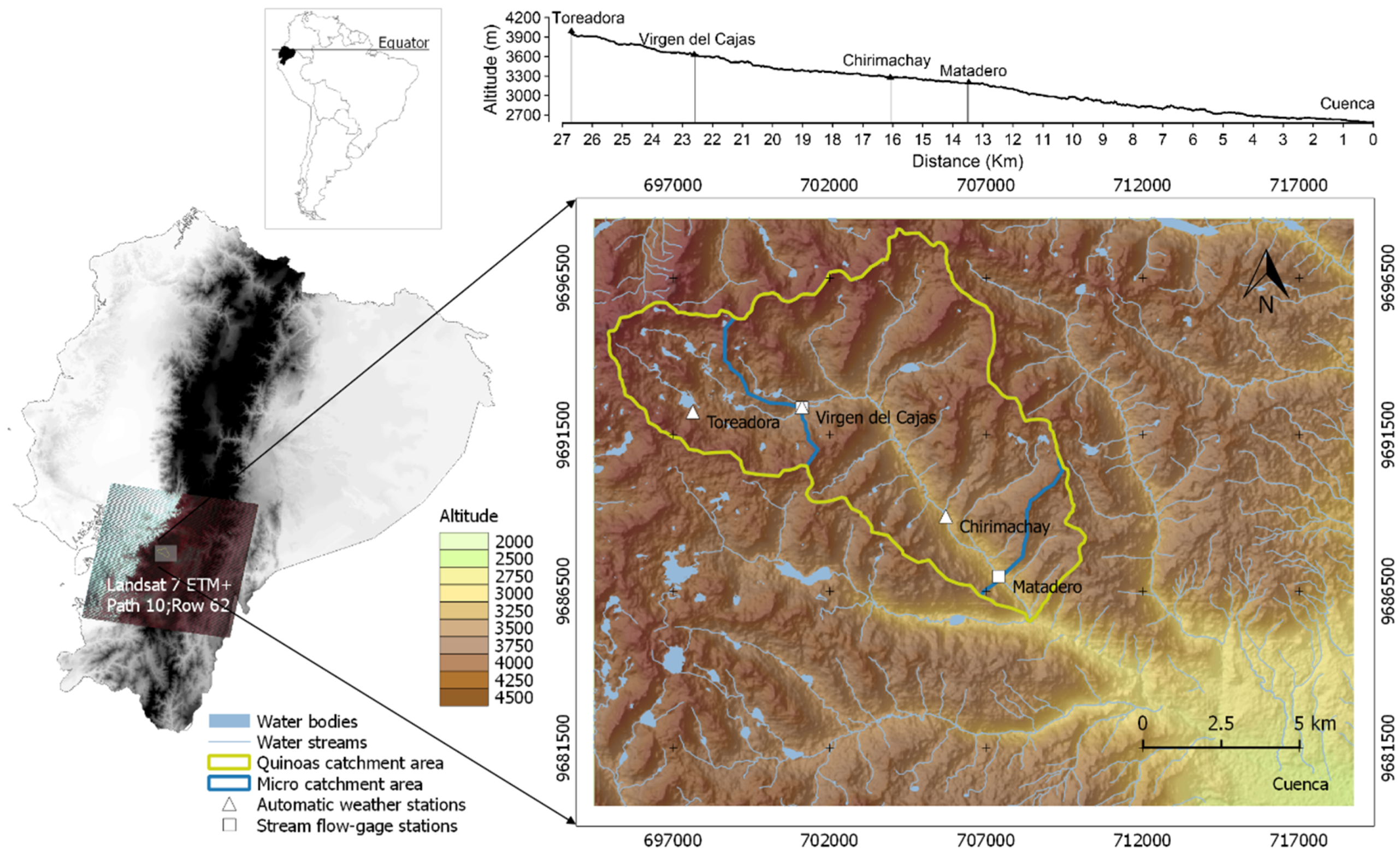
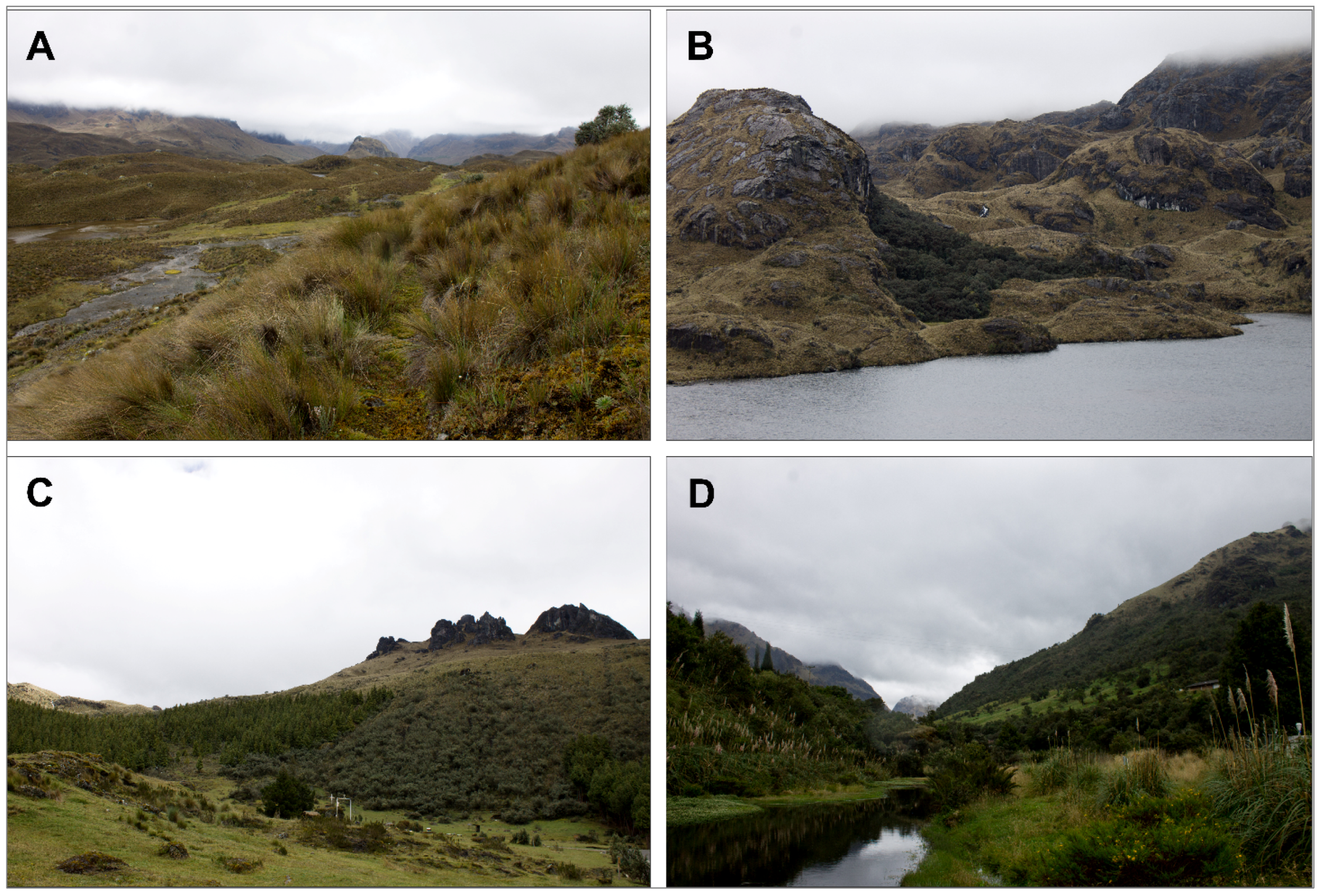
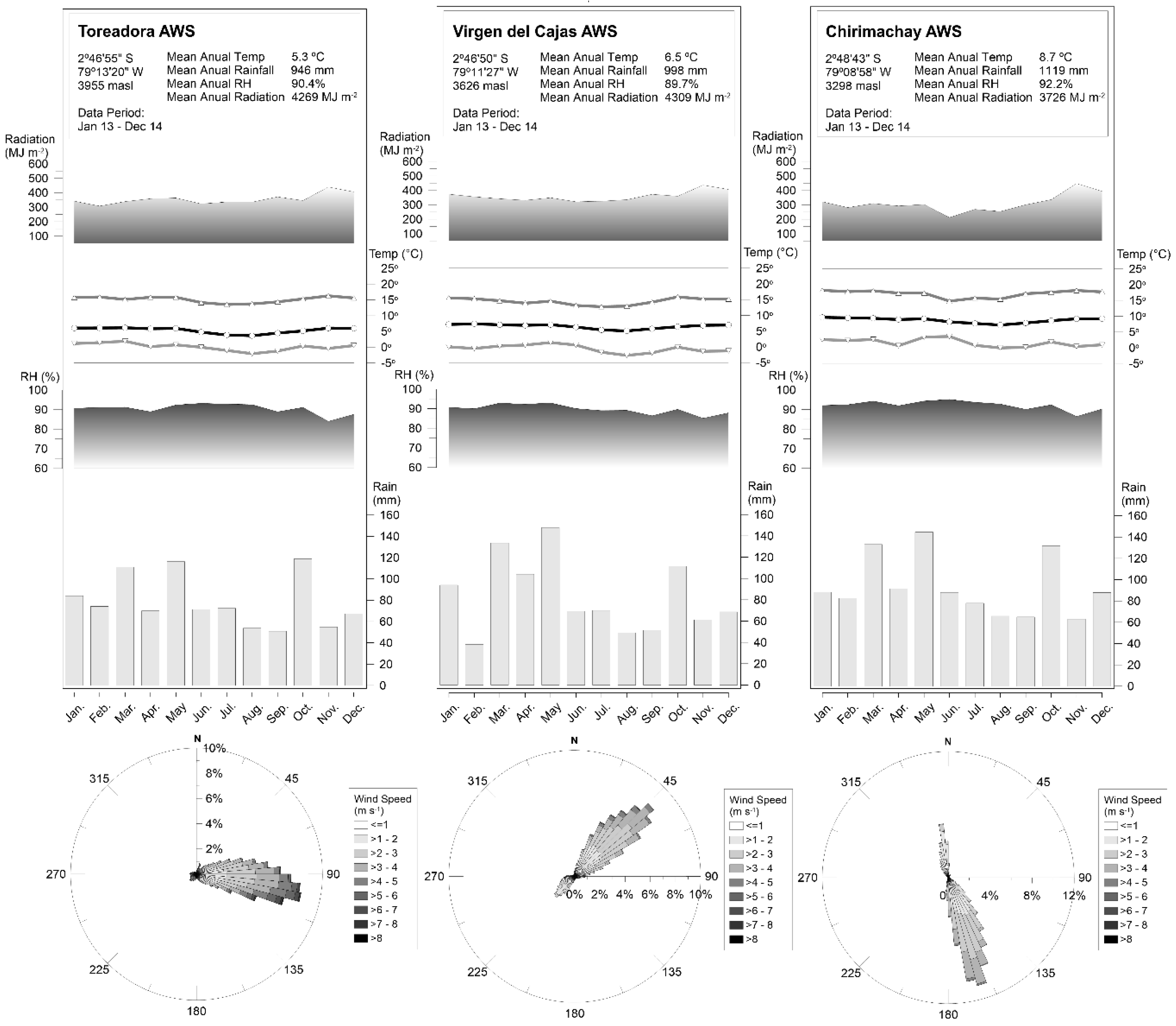


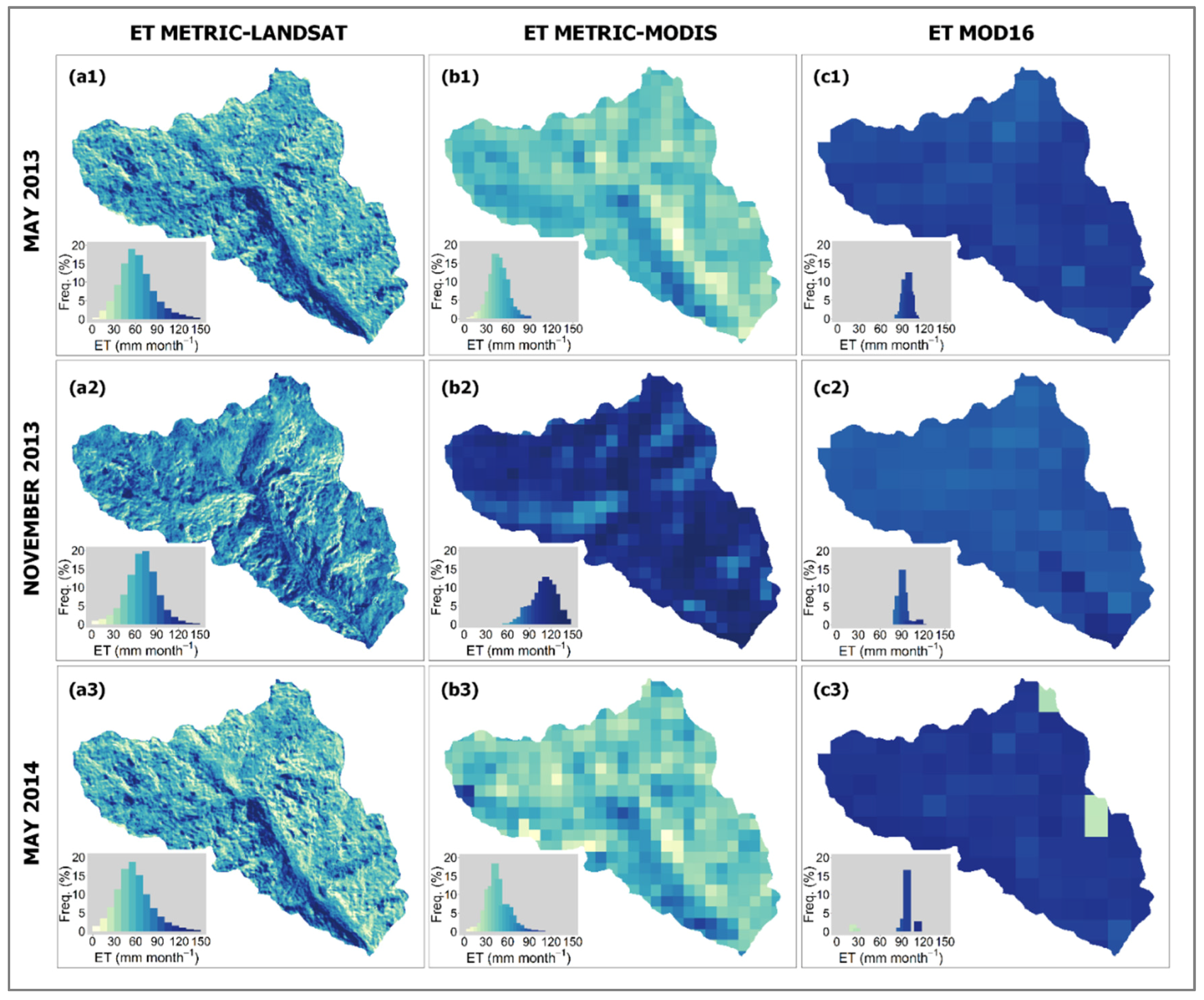
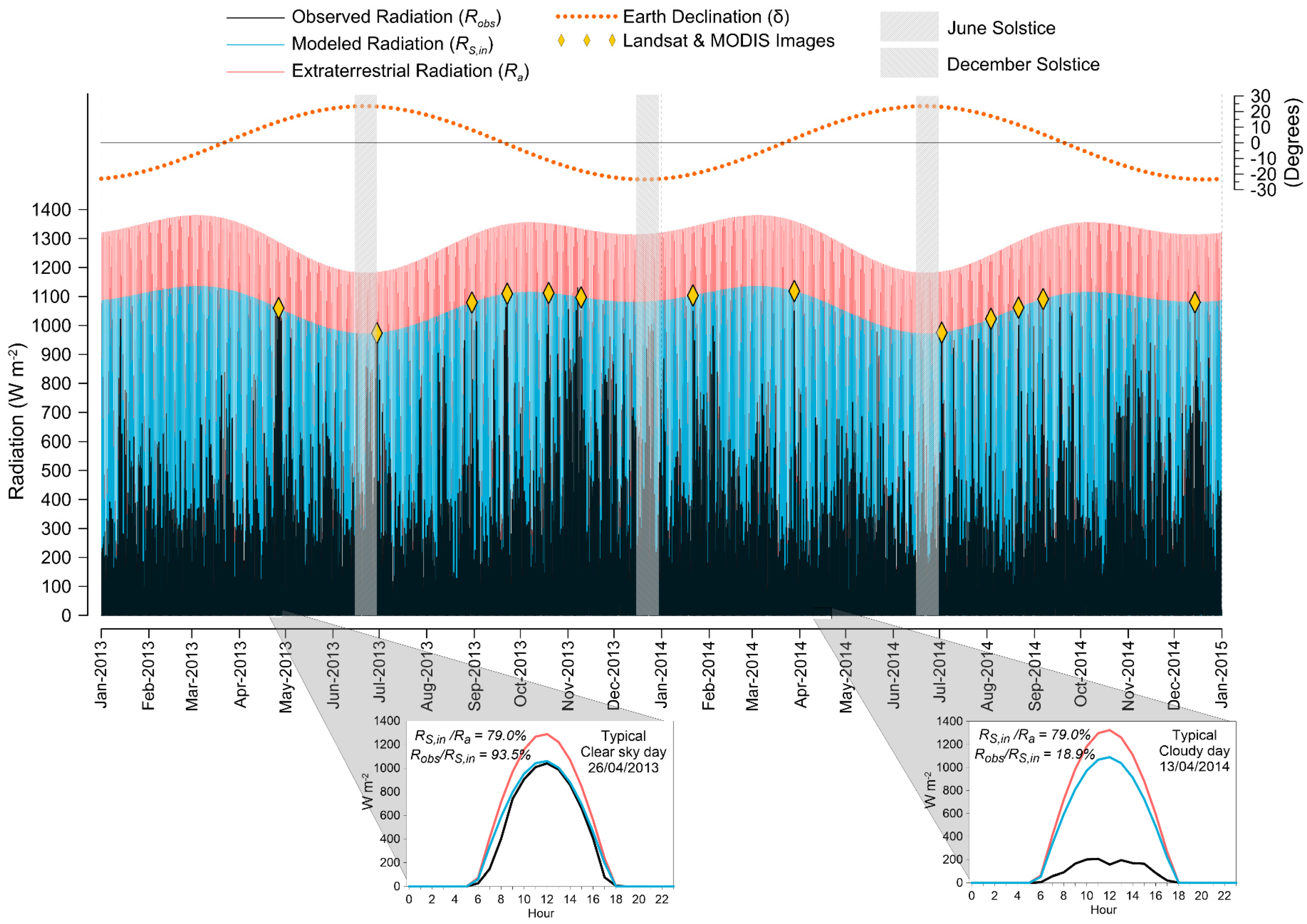

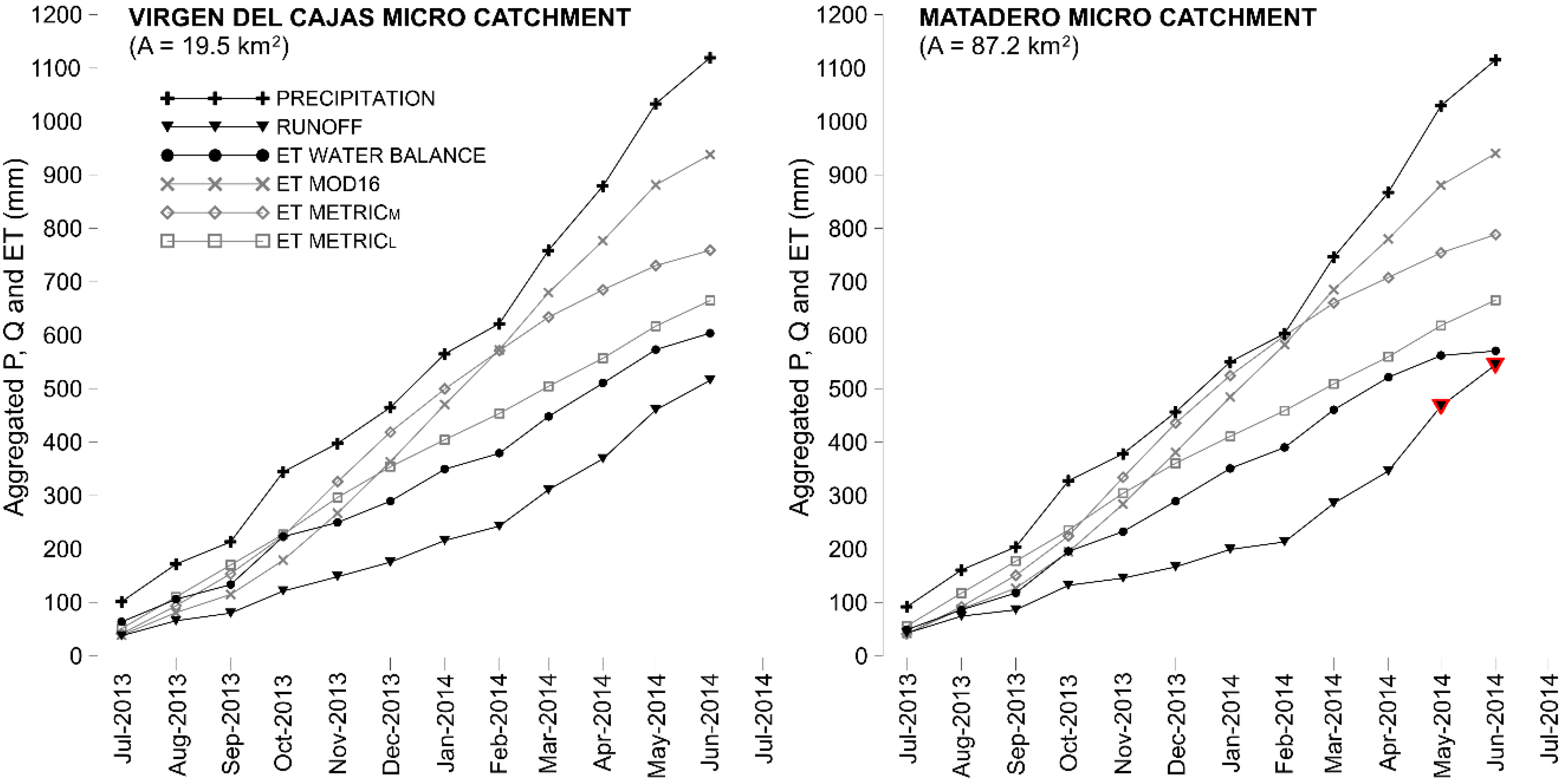
| Station | Latitude and Longitude (UTM) | Elevation (masl) | Vegetation Type and Approximate Height |
|---|---|---|---|
| Toreadora 1 | 9692227.1; 697618.7 | 3955 | Tussock Grass (“Pajonal”) (0.40 m) |
| Virgen del Cajas 1,2 | 9692382.2; 701110.7 | 3626 | Mixed High Grass (0.40 m)/Low Grass (0.15 m) |
| Chirimachay 1 | 9688895.5; 705703.9 | 3298 | Mixed: High Grass (0.40 m)/Native Subalpine and Forest (8 m) |
| Matadero 2 | 9686975.5; 707391.7 | 320 | Mixed: High Grass (0.40 m)/Native Subalpine and Forest (>8 m) |
| Variable | Sensors | Unit | Accuracy | Time Resolution |
|---|---|---|---|---|
| Air Temperature/Relative Humidity 1,2 | Campbell CS-215 + Radiation Shield | °C/% RH | ±0.3 °C/±2% RH | 5 min |
| Wind Speed and Direction 1 | Met-One 034B Wind Set | m·s−1 | ±0.11 m·s−1 | 5 min |
| Pressure 1,2 | Vaisala PTB110 Barometer | hPa | ±0.3 hPa | 5 min |
| Solar Radiation 1 | Campbell CS300 Pyranometer | W·m−2 | ±5% daily total | 5 min |
| Rainfall 1 | Texas TE525MM Rain Gage | mm | ±1% | 5 min |
| Water Level 2 | Campbell SR50A-L Sonic Ranging Sensor | m | ±0.025 m | 5 min |
| Landsat 7 ETM + SLC-off Scene ID | Date | Path/Row | Cloud and Cloud-Shadow over the Quinoas Study Area * (%) |
| LE70100622013116EDC00 | 26 April 2013 | 10/62 | 0.0 |
| LE70100622013180EDC00 | 29 June 2013 | 10/62 | <9.4 |
| LE70100622013292EDC00 | 19 October 2013 | 10/62 | <12.1 |
| LE70100622014087EDC00 | 28 March 2014 | 10/62 | <9.5 |
| LE70100622014183EDC00 | 2 July 2014 | 10/62 | <12.5 |
| LE70100622014215EDC00 | 3 August 2014 | 10/62 | <38.0 |
| MODIS-Terra Scene ID | Date | Tile Covering | Cloud and Cloud-Shadow over the Quinoas Study Area * (%) |
| MOD02HKM.A2013118.1530 | 28 April 2013 | H10/V9 | <5.0 |
| MOD02HKM.A2013242.1555 | 30 August 2013 | H10/V9 | <3.0 |
| MOD02HKM.A2013265.1600 | 22 September 2013 | H10/V9 | <30.0 |
| MOD02HKM.A2013313.1600 | 9 November 2013 | H10/V9 | <8.0 |
| MOD02HKM.A2014021.1555 | 21 January 2014 | H10/V9 | <35.5 |
| MOD02HKM.A2014087.1540 | 28 March 2014 | H10/V9 | <30.9 |
| MOD02HKM.A2014233.1530 | 21 August 2014 | H10/V9 | <20.0 |
| MOD02HKM.A2014249.1530 | 6 September 2014 | H10/V9 | <5.0 |
| MOD02HKM.A2014348.1600 | 14 December 2014 | H10/V9 | <2.5 |
| MOD16 Global ET Product | Date | Tile Covering | |
| MOD16A2 monthly imagery | January 2013 to December 2014 | H10/V9 |
| n | November 2013 (High Radiation Month) | April 2014 (Low Radiation, Rainy Month) | Period. Diff. | |||||
|---|---|---|---|---|---|---|---|---|
| Mean | Max | SD | Mean | Max | SD | |||
| ET METRICL (mm·day−1) | ||||||||
| Tussock grass sites | 6 | 2.27 | 3.56 | 0.63 | 1.64 | 2.76 | 0.47 | −0.63 |
| Polylepis sp. forest sites | 4 | 2.68 | 4.46 | 0.84 | 2.36 | 3.79 | 0.72 | −0.32 |
| Pinus sp. forest sites | 4 | 2.83 | 4.37 | 0.85 | 2.44 | 3.83 | 0.72 | −0.39 |
| Water body | 3 | 4.37 | 7.01 | 1.33 | 4.46 | 7.02 | 1.34 | 0.09 |
| ET METRICM (mm·day−1) | ||||||||
| Tussock grass sites | 6 | 3.31 | 5.07 | 0.88 | 1.90 | 3.44 | 0.54 | −1.41 |
| Polylepis sp. forest sites | 4 | 3.98 | 5.87 | 1.00 | 1.69 | 3.41 | 0.53 | −2.29 |
| Pinus sp. forest sites | 4 | 3.55 | 4.93 | 0.94 | 1.96 | 2.93 | 0.52 | −1.59 |
| Water body | 3 | 3.66 | 5.32 | 0.95 | 2.06 | 3.68 | 0.60 | −1.6 |
| METRIC Difference (means and max.) (mm·day−1) | ||||||||
| Tussock grass sites | 1.04 | 1.51 | 0.26 | 0.68 | ||||
| Polylepis sp. forest sites | 1.3 | 1.41 | −0.67 | −0.38 | ||||
| Pinus sp. forest sites | 0.72 | 0.56 | −0.48 | −0.9 | ||||
| Water body | −0.71 | -1.69 | −2.4 | −3.34 | ||||
| Virgen del Cajas Micro Catchment | Matadero Micro Catchment | |||||||
|---|---|---|---|---|---|---|---|---|
| ET Water Balance | ET METRICL | ET METRICM | ET MOD16 | ET Water Balance | ET METRICL | ET METRICM | ET MOD16 | |
| Annual Total (mm·year−1) | 603.91 | 664.91 | 759.04 | 937.91 | 570.70 | 665.82 | 788.53 | 940.50 |
| Annual Error (mm·year−1) | 61.01 | 155.14 | 334.00 | 95.12 | 217.84 | 369.80 | ||
| Percent Annual Error (%) | 10.10 | 25.69 | 55.31 | 16.67 | 38.17 | 64.80 | ||
| Monthly Mean (mm·month−1) | 50.33 | 55.41 | 63.25 | 78.16 | 47.56 | 55.49 | 65.71 | 78.37 |
| Monthly MBE (mm·month−1) | 5.08 | 12.93 | 27.83 | 7.93 | 18.15 | 30.82 | ||
| Percent Monthly MBE (%) | 30.42 | 51.37 | 76.15 | 57.36 | 65.79 | 108.28 | ||
| Monthly RMSE (mm·month−1) | 22.02 | 33.06 | 41.69 | 21.23 | 30.61 | 39.03 | ||
© 2016 by the authors; licensee MDPI, Basel, Switzerland. This article is an open access article distributed under the terms and conditions of the Creative Commons by Attribution (CC-BY) license (http://creativecommons.org/licenses/by/4.0/).
Share and Cite
Carrillo-Rojas, G.; Silva, B.; Córdova, M.; Célleri, R.; Bendix, J. Dynamic Mapping of Evapotranspiration Using an Energy Balance-Based Model over an Andean Páramo Catchment of Southern Ecuador. Remote Sens. 2016, 8, 160. https://doi.org/10.3390/rs8020160
Carrillo-Rojas G, Silva B, Córdova M, Célleri R, Bendix J. Dynamic Mapping of Evapotranspiration Using an Energy Balance-Based Model over an Andean Páramo Catchment of Southern Ecuador. Remote Sensing. 2016; 8(2):160. https://doi.org/10.3390/rs8020160
Chicago/Turabian StyleCarrillo-Rojas, Galo, Brenner Silva, Mario Córdova, Rolando Célleri, and Jörg Bendix. 2016. "Dynamic Mapping of Evapotranspiration Using an Energy Balance-Based Model over an Andean Páramo Catchment of Southern Ecuador" Remote Sensing 8, no. 2: 160. https://doi.org/10.3390/rs8020160






